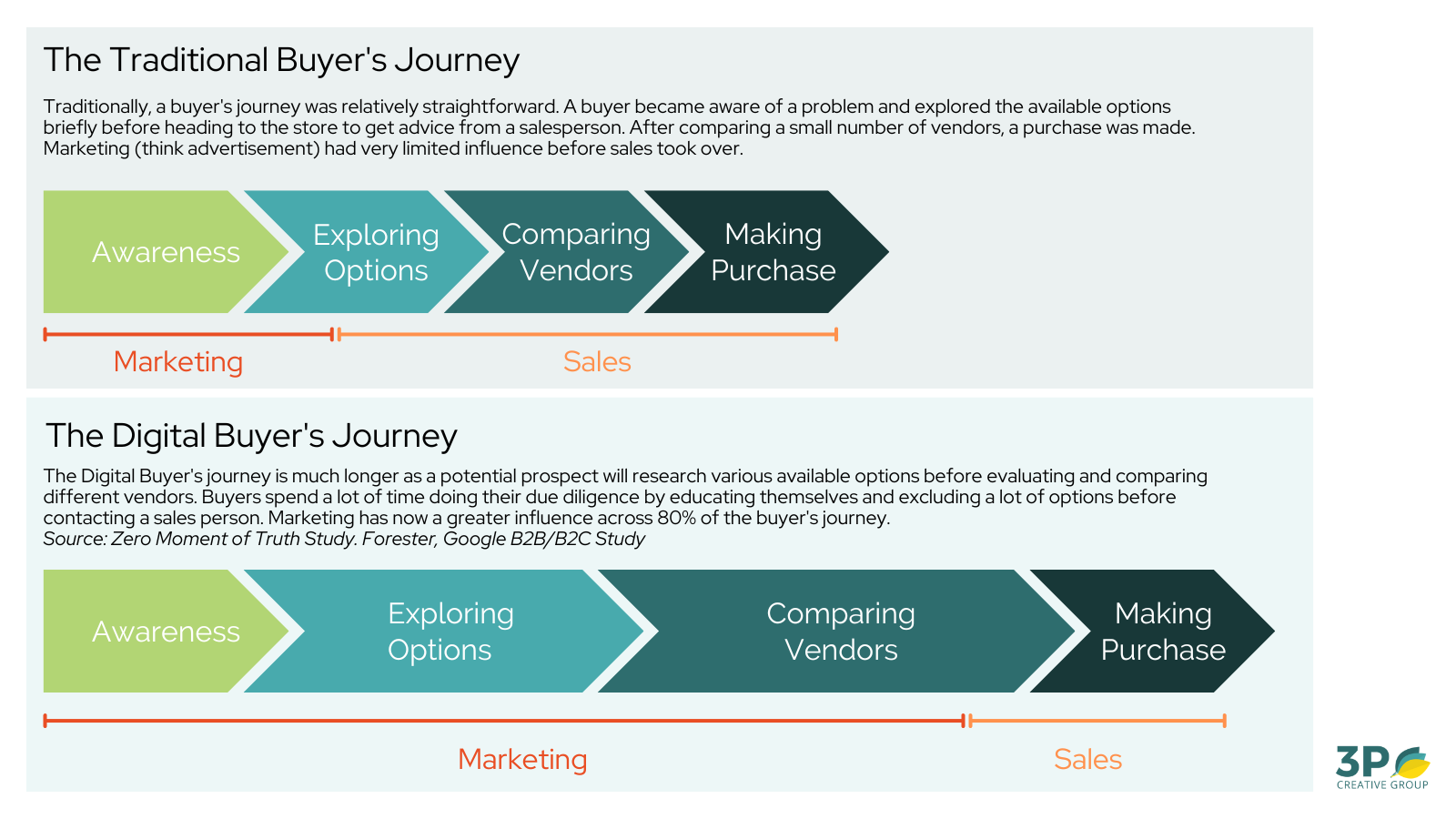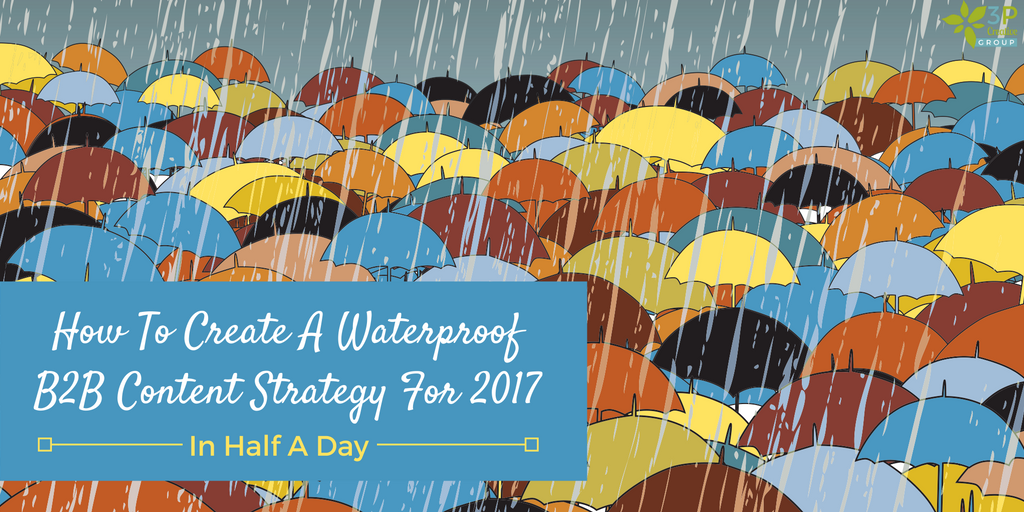Top B2B Content Marketing Challenge: Creating Content For The Entire Buyer's Journey
Are you seeing drastic declines in conversion rates? Are you struggling to move prospects through the buyer's journey? If so, you are not alone. Sixty-one percent of B2B content marketers say the biggest challenge they currently face is "creating content that appeals to different stages of the buyer’s journey."
Having written more than 1,000 blog posts for the B2B space and generated up to $1 million in directly attributed revenue for a single blog post, I know how important creating content across the entire buyer's cycle is. But I have also worked with dozens of companies and know what the root cause of the challenge is.
In this article, we will explore why it is important to create content for each stage of the buyer's journey, and we'll uncover the two obstacles you need to overcome to do this successfully:
- Aligning your marketing and sales teams (because they know what buyers are asking and what their worries, fears, and concerns are) and
- Empowering your subject matter experts to provide you with the expertise and experience required to create outstanding content.
Not surprisingly, these two are among the top challenges B2B marketers face today.
Why Creating Content For Every Stage Of The Buyer's Journey Is Important
About ten years ago, in the early stages of Inbound Marketing, marketers focused on attracting strangers to the website by writing mostly awareness-stage blog posts, optimizing them for search engines, and posting on social media.
Buyers then further explored the offered solutions or products on product pages and soon called sales to learn more about the offered features, resulting benefits, and pricing options. They did this for the vendors they had shortlisted to compare the options and decide.

Today, however, the buyer's journey has significantly changed. Modern buyers (we call them Digital Buyers) prefer to do as much research by themselves as possible, and many cut out the salesperson completely. In fact, "55% of buyers said they now rely more on content to research and make purchasing decisions than they did a year ago" and 62% of B2B buyers say they engage with three to seven pieces of content before connecting with a salesperson, according to a recent Demand Gen Report.
This means that marketing has a far greater impact on the buyer's journey than ever before and covers more stages in the now longer decision-making process. This means it is crucial that you create content across all stages of the buyer's journey.
1. You Need To Align Your Sales & Marketing Teams Better
We have probably all heard this somewhere before: When marketing and sales teams are properly aligned, businesses are better equipped to meet customer needs and increase profitability. Companies with fully aligned marketing and sales teams have 36% higher customer retention rates and generate 209% more revenue from their marketing efforts than those without alignment.
Furthermore, when the two teams are working together, they can create more effective campaigns and better target the right prospects. This leads to higher conversion rates and increased revenue from marketing efforts.
But for you as a content marketer and content creator, the biggest reason marketing and sales should be not only aligned but united is because marketing now has a much bigger influence over the buyer's journey than ever before (see above) but needs the input from sales to understand the prospect's fears, worries, and concerns. On the other hand, sales should be your biggest distributor and evangelist for your content (not social media or ads).
Create An Internal Revenue Team
So, how can you achieve this alignment?
The answer is very simple. Create a revenue team that includes key members from your sales team, you as a content manager, and your videographer if you have one. You will meet for 30 minutes every week or 45 minutes every two weeks. I have found that the second cadence works best.
In this meeting, your sales team members report back to you which questions they have encountered in the past two weeks, while you share with them which pieces of content have been published and which are in the pipeline.
For more information on creating a revenue team, check out this article or click below to watch a dedicated, free training series on revenue teams.
2. You Are Underutilizing Your Secret Weapon: Your Subject Matter Experts (SMEs)
There are two ways of creating content: writing content based on primary subject matter expertise (either by interviewing an SME or writing the content yourself if you are one) or conducting secondary (sometimes even tertiary) research and regurgitating what others have already said. Obviously, since you are the expert in your industry, prospective buyers want to hear from you. This creates not only thought leadership for you but trust — the most valuable thing you can build.
However, according to a recent Content Marketing Institute Survey, 34% of content marketers complain that gaining sufficient access to subject matter experts is challenging.
SME Interviews Need To Become A KPI
This challenge is partially due to organizational issues. As an organization, you need to create a standardized process that prepares internal subject matter experts for their interviews (including training them on how to be great SMEs), but also makes participating and contributing in the process a job requirement. This shouldn't be seen as "doing marketing a favor" or an additional workload they must squeeze in, but as a KPI they need to meet regularly.
Making The Interview Experience Positive
In addition, you, as the writer, can do a lot to make the interview experience as positive as possible to increase the likelihood of them allowing you to interview them again. Make sure your process is efficient and maximizes your time together with the SME. For example, be sure to record and transcribe your meetings so the outcome is scannable and searchable. Build rapport with your SMEs over time, always come prepared to the interviews, and dig beyond the surface to get to the good stuff: their unique knowledge and expertise.
Each Stage In The Buying Process Requires Different Content Types
There are countless content formats you can use, but you will want to deploy those that have the highest engagement and conversion success for each step of the buyer’s journey.
Awareness
The first stage of the buyer's journey is the awareness stage. Here, potential buyers are gathering information about a problem they are facing or a need they have. They are not considering a specific product or solution yet, but are exploring different options.
Examples of content types that are successful at this stage include blog posts (especially "Potential Problem" and "Cost/Price" Big 5 articles), infographics, podcasts, and videos. Depending on your industry, checklists, project plans, templates, and other practical (DIY) tools might work well, too.
Consideration
The second stage of the buyer's journey is the consideration stage. At this stage, potential buyers are researching different options to find the product or solution that best suits their needs. To stand out in this stage, content creators must create content that speaks to the needs of the potential customer.
Examples of content types that are successful in this stage include product assessments, webinars, comparison guides, "Best of" or "Versus/Comparison" blog posts, case studies, and white papers. These types of content allow potential customers to make an informed decision about the product or solution that is best for them.
Decision
Finally, the third stage of the buyer's journey is the decision stage. This is reached when potential buyers are ready to purchase a product or solution. Rather than notching up the "sales-ness" of your content to convince people to buy your solution, invest in content that creates trust. Focus on creating content that provides helpful, unbiased information that lets the buyer make an informed decision.
Examples of successful content types include user reviews, third-party analyst reports, cost and ROI calculators, product demonstrations, and "Customer Journey" and "Claims We Make" videos. These types of content allow potential customers to understand the features and benefits of the product or solution and make a confident purchase decision.
Conclusion
In summary, creating content that appeals to different stages of the buyer's journey is a difficult challenge that many B2B content marketers face. Fortunately, by aligning the marketing and sales team, and empowering the subject matter experts to provide expertise and experience, it is possible to create content that resonates with buyers throughout the journey.
Share this
You May Also Like
These Related Stories

How To Create A Waterproof B2B Content Strategy In Half A Day

B2B Content Marketing: How Much Does It Cost Per Month & How Can The Cost Be Reduced?

.png?width=250&height=125&name=TrustBuilderLogoWhiteTranspBackgr(250x125%20px).png)




No Comments Yet
Let us know what you think